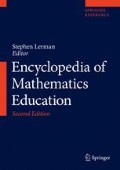Access this chapter
Tax calculation will be finalised at checkout
Purchases are for personal use only
Notes
- 1.
An instrument is here defined as a mixed entity composed of a part of the artifact and a scheme, a scheme being, according to Vergnaud (1996), the invariant organization of activity to perform a type of task, including rules of action and specific knowledge, produce and spring of the activity.
References
Artigue M (2002) Learning mathematics in a CAS environment: the genesis of a reflection about instrumentation and the dialectics between technical and conceptual work. Int J Comput Math Learn 7(3):245–274
Bacon F (1620/1858) Novum Organum. In: Spedding J, Ellis RL, Heath DD (eds) The collected works of Francis Bacon. Longmans, London
Balacheff N (1994) Didactique et intelligence artificielle. Recherches en Didactique des Mathématiques 14(1/2):9–42
Drijvers P, Doorman M, Boon P, Reed H, Gravemeijer K (2010) The teacher and the tool: instrumental orchestrations in the technology-rich mathematics classroom. Educ Stud Math 75(2):213–234
Engeström Y, Miettinen R, Punamäki RL (1999) Perspectives on activity theory. Cambridge University Press, Cambridge
Gibson JJ (1979) The ecological approach to visual perception. Houghton Mifflin Harcourt (HMH), Boston
Gueudet G, Trouche L (2009) Towards new documentation systems for mathematics teachers? Educ Stud Math 71(3):199–218
Guin D, Trouche L (1999) The complex process of converting tools into mathematical instruments. The case of calculators. Int J Comput Math Learn 3(3):195–227
Guin D, Ruthven, Trouche L (eds) (2005) The didactical challenge of symbolic calculators: turning a computational device into a mathematical instrument. Springer, New York
Lagrange J-B, Artigue M, Laborde C, Trouche L (2003) Technology and mathematics education: a multidimensional study of the evolution of research and innovation. In: Bishop AJ, Clements MA, Keitel C, Kilpatrick J, Leung FKS (eds) Second international handbook of mathematics education. Kluwer, Dordrecht, pp 239–271
Maschietto M, Trouche L (2010) Mathematics learning and tools from theoretical, historical and practical points of view: the productive notion of mathematics laboratories. ZDM Int J Math Educ 42(1):33–47
Monaghan J, Trouche L, Borwein J (2016) Tools and mathematics: instruments for learning. Springer, New York
Noss R, Hoyles C (eds) (1996) Windows on mathematical meanings – learning cultures and computers. Kluwer, Dordrecht
Proust C (2012) Masters’ writings and students’s writings: school material in Mesopotamia. In: Gueudet G, Pepin B, Trouche L (eds) From text to ‘lived’ resources. Mathematics curriculum materials and teacher development. Springer, New York, pp 161–179
Salaün J-M (2012) Vu, lu, su, les architectes de l’information face à l’oligopole du web. La découverte, Paris
Trouche L (2004) Managing the complexity of human/machine interactions in computerized learning environments: guiding students’ command process through instrumental orchestrations. Int J Comput Math Learn 9:281–307
Trouche L (2005) An instrumental approach to mathematics learning in symbolic calculators environments. In: Guin D, Ruthven K, Trouche L (eds) The didactical challenge of symbolic calculators: turning a computational device into a mathematical instrument. Springer, New York, pp 137–162
Trouche L, Drijvers P (2010) Handheld technology for mathematics education, flashback to the future. ZDM Int J Math Educ 42(7):667–681
Vergnaud G (1996) The theory of conceptual fields. In: Steffe LP, Nesher P, Cobb P, Goldin GA, Greer B (eds) Theories of mathematical learning. Lawrence Erlbaum Ass, Mahwah, pp 219–239
Verillon P, Rabardel P (1995) Cognition and artifact: a contribution to the study of thought in relation to instrument activity. Eur J Psychol Educ 9(3):77–101
Vygotsky LS (1981) The instrumental method in psychology. In: Wertsch JW (ed) The concept of activity in Soviet psychology. M.E. Sharpe, Armonk
Acknowledgments
Thanks to Ghislaine Gueudet and Birgit Pepin for their reading of the first version of this article.
Author information
Authors and Affiliations
Corresponding author
Editor information
Editors and Affiliations
Section Editor information
Rights and permissions
Copyright information
© 2020 Springer Nature Switzerland AG
About this entry
Cite this entry
Trouche, L. (2020). Instrumentation in Mathematics Education. In: Lerman, S. (eds) Encyclopedia of Mathematics Education. Springer, Cham. https://doi.org/10.1007/978-3-030-15789-0_80
Download citation
DOI: https://doi.org/10.1007/978-3-030-15789-0_80
Published:
Publisher Name: Springer, Cham
Print ISBN: 978-3-030-15788-3
Online ISBN: 978-3-030-15789-0
eBook Packages: EducationReference Module Humanities and Social SciencesReference Module Education

